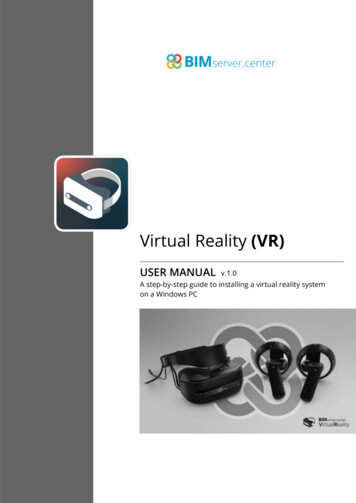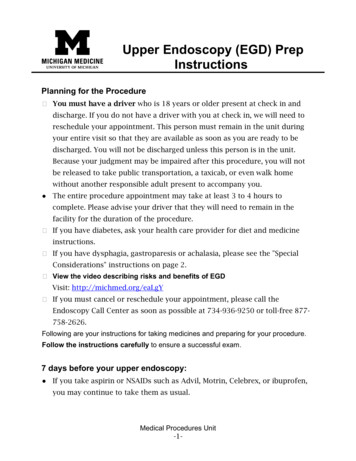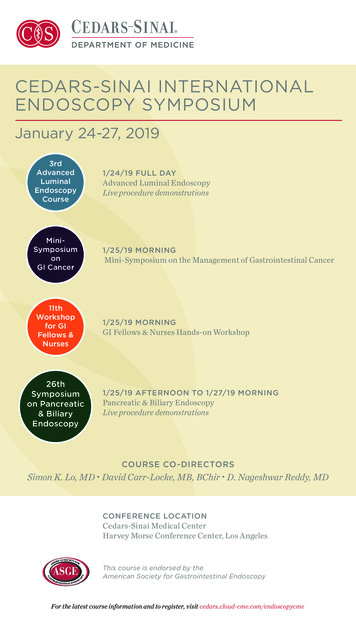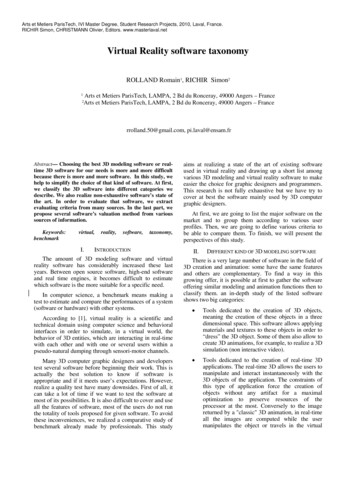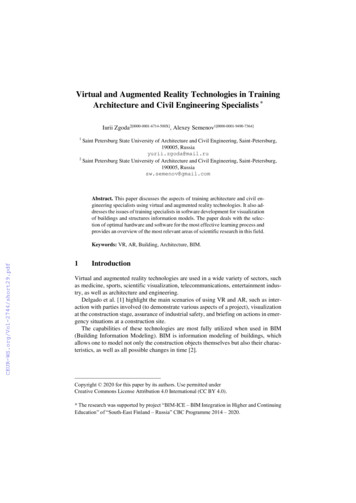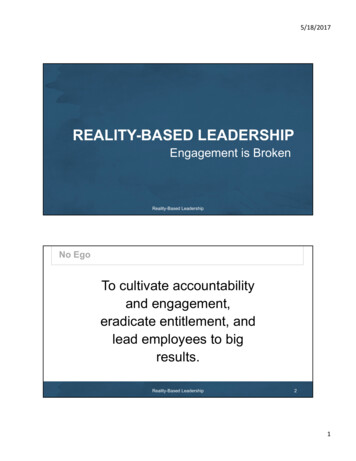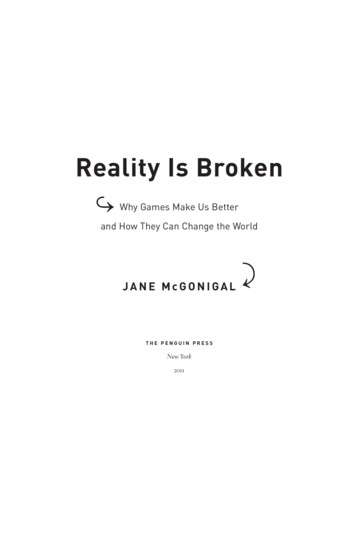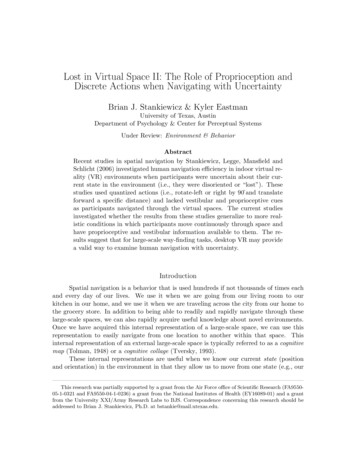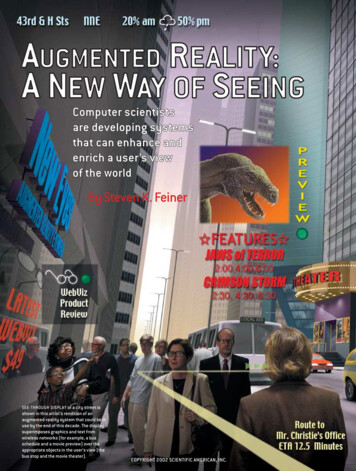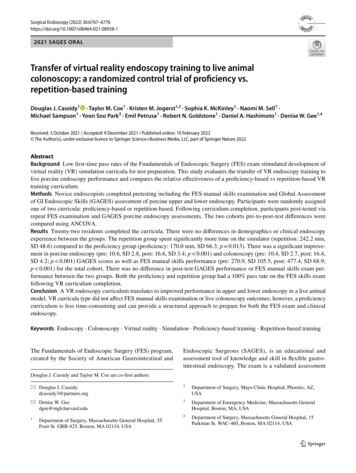
Transcription
Surgical Endoscopy (2022) 8958-1and Other Interventional Techniques2021 SAGES ORALTransfer of virtual reality endoscopy training to live animalcolonoscopy: a randomized control trial of proficiency vs.repetition‑based trainingDouglas J. Cassidy1 · Taylor M. Coe1 · Kristen M. Jogerst1,2 · Sophia K. McKinley1 · Naomi M. Sell1 ·Michael Sampson1 · Yoon Soo Park3 · Emil Petrusa1 · Robert N. Goldstone1 · Daniel A. Hashimoto1 · Denise W. Gee1,4Received: 3 October 2021 / Accepted: 9 December 2021 / Published online: 10 February 2022 The Author(s), under exclusive licence to Springer Science Business Media, LLC, part of Springer Nature 2022AbstractBackground Low first-time pass rates of the Fundamentals of Endoscopic Surgery (FES) exam stimulated development ofvirtual reality (VR) simulation curricula for test preparation. This study evaluates the transfer of VR endoscopy training tolive porcine endoscopy performance and compares the relative effectiveness of a proficiency-based vs repetition-based VRtraining curriculum.Methods Novice endoscopists completed pretesting including the FES manual skills examination and Global Assessmentof GI Endoscopic Skills (GAGES) assessment of porcine upper and lower endoscopy. Participants were randomly assignedone of two curricula: proficiency-based or repetition-based. Following curriculum completion, participants post-tested viarepeat FES examination and GAGES porcine endoscopy assessments. The two cohorts pre-to-post-test differences werecompared using ANCOVA.Results Twenty-two residents completed the curricula. There were no differences in demographics or clinical endoscopyexperience between the groups. The repetition group spent significantly more time on the simulator (repetition: 242.2 min,SD 48.6) compared to the proficiency group (proficiency: 170.0 min, SD 66.3; p 0.013). There was a significant improvement in porcine endoscopy (pre: 10.6, SD 2.8, post: 16.6, SD 3.4; p 0.001) and colonoscopy (pre: 10.4, SD 2.7, post: 16.4,SD 4.2; p 0.001) GAGES scores as well as FES manual skills performance (pre: 270.9, SD 105.5, post: 477.4, SD 68.9;p 0.001) for the total cohort. There was no difference in post-test GAGES performance or FES manual skills exam performance between the two groups. Both the proficiency and repetition group had a 100% pass rate on the FES skills examfollowing VR curriculum completion.Conclusion A VR endoscopy curriculum translates to improved performance in upper and lower endoscopy in a live animalmodel. VR curricula type did not affect FES manual skills examination or live colonoscopy outcomes; however, a proficiencycurriculum is less time-consuming and can provide a structured approach to prepare for both the FES exam and clinicalendoscopy.Keywords Endoscopy · Colonoscopy · Virtual reality · Simulation · Proficiency-based training · Repetition-based trainingThe Fundamentals of Endoscopic Surgery (FES) program,created by the Society of American Gastrointestinal andEndoscopic Surgeons (SAGES), is an educational andassessment tool of knowledge and skill in flexible gastrointestinal endoscopy. The exam is a validated assessmentDouglas J. Cassidy and Taylor M. Coe are co-first authors.* Douglas J. Cassidydcassidy3@partners.org2Department of Surgery, Mayo Clinic Hospital, Phoenix, AZ,USA* Denise W. Geedgee@mgh.harvard.edu3Department of Emergency Medicine, Massachusetts GeneralHospital, Boston, MA, USA4Department of Surgery, Massachusetts General Hospital, 15Parkman St. WAC‑460, Boston, MA 02114, USA1Department of Surgery, Massachusetts General Hospital, 55Fruit St. GRB‑425, Boston, MA 02114, USA13Vol.:(0123456789)
6768tool that consists of both a cognitive knowledge and manualskills assessment, the latter of which involves five tasksassessing the following skills: scope navigation, loop reduction, mucosal inspection, retroflexion, and targeting [1]. Theskills portion of the exam is hosted on the 3D Systems (formerly Simbionix) GI Mentor endoscopic simulator, a virtualreality (VR) endoscopy simulator that has been the subjectof multiple studies assessing construct validity [2–5]. Virtualreality simulators allow for the utilization of proficiencybased curricula, which require the identification of constructvalid tasks and performance-based rather than time- or repetition-based criteria for completion [6]. A curriculum forattainment of proficient performance accounts for differentrates of learning in individuals and ensures that trainees aretruly acquiring an acceptable level of skill prior to performing procedures [6].Beginning in 2018, all surgical residents are requiredto pass the FES examination to graduate; thus, there is aneed for an effective curriculum to prepare trainees to passthis exam. The urgency for effective endoscopy curriculumhad been heightened by work that demonstrated poor baseline pass rates of surgical trainees, suggesting that standard endoscopy experience is insufficient [7]. Fortunately,a few proficiency-based curricula have been developed tohelp trainees prepare for the FES manual skills examination[8–11]. Despite improved FES exam pass rates, no studieshave assessed the impact of a VR training curriculum ontrainee’s endoscopic skills in a live animal model or patients.Simulation-based endoscopy training has been shown toimprove performance on a porcine model and studies haveshown a correlation between live colonoscopy and FES manual skills assessment performance [12, 13]. The ultimate goalof the FES curriculum and endoscopic training is to preparesurgeons to perform endoscopy on real patients, and thus,understanding the optimal VR training preparation for colonoscopy in a live animal model is relevant for all generalsurgery training programs. The purpose of this study is toevaluate the transfer of VR endoscopy training to live porcinecolonoscopy and to compare the relative effectiveness of twodifferent VR training paradigms in preparing for live colonoscopy: proficiency-based training vs repetition-based training.Materials and methodsParticipantsNovice endoscopists, defined as trainees who have completedfewer than 10 colonoscopies, were recruited via email froma single large academic surgical residency between January2020 and June 2021. At our institution, residents complete adedicated endoscopy rotation during their second postgraduate year; therefore, recruitment was limited to surgical interns13Surgical Endoscopy (2022) 36:6767–6776(categorical general surgery and general surgery preliminaryinterns) whose rotations do not generally include colonoscopies. Participants were excluded if they had previous participation in a simulation-based endoscopy training curriculumor had previously taken the FES examination.InstrumentationThe GI Mentor (3D Systems, Rock Hill, SC) is a virtualreality endoscopic simulator that is designed to assist in theteaching and practice of both upper and lower gastrointestinal endoscopy. This platform was chosen by SAGES for theadministration of the FES examination and as a result, wasselected for use in this study [1].Study designOur Institutional Review Board (IRB) exempted this protocol from further review with regards to human subjectprotections (IRB Protocol: 2015P000522-AME4) as anamendment and extension of our research team’s prior workon FES VR curricula [10]. The Partners Healthcare Institutional Animal Care and Use Committee (IACUC) approvedthe porcine endoscopy protocol for use of swine in surgicaltraining (IACUC Protocol #2019N000140).This study employed a randomized control design. Participants completed baseline demographics surveys and wereprovided with a one-on-one familiarization session with thesimulator by an experienced operator, including a full demonstration and an opportunity to ask questions. All participantsunderwent pre-testing by completing the FES manual skillsexamination and performing a porcine endoscopy and colonoscopy assessed with the Global Assessment of GI Endoscopic Skills (GAGES) scoring system, a tool that has beenshown to have validity evidence for technical skills in flexibleendoscopy (Appendix A and B) [14]. Healthy male Yorkshirepigs (30–40 kg) underwent a bowel preparation consisting of aclear liquid diet and polyethylene glycol starting the day priorto the procedure. Endoscopy was performed in the left lateraldecubitus position under general anesthesia and animals wereeuthanized at the conclusion of the experiment. A single channel colonoscope (KARL STORZ Endoscopy-America, USA)was used for both the upper and lower endoscopy.Participants were then randomized in modified matchedpairs to one of two VR curricula: proficiency-based trainingor repetition-practice based training. The proficiency groupcompleted practice GI Mentor VR tasks with expert levelbenchmarks as described in Hashimoto et al. (Appendix C)[10]. Each participant in the proficiency group was requiredto meet the benchmarks for each task, as determined byexpert performance, on two consecutive occasions. In comparison, the repetition group completed the same tasks as theproficiency group but for a set number of repetitions (10),
Surgical Endoscopy (2022) 36:6767–6776regardless of performance quality or benchmark achieved.For each group, a FES-certified instructor was available toprovide coaching during the first repetition of each task.Subsequent repetitions in the two groups were self-directedby the participant with feedback provided by the simulator(e.g., total time, proficiency achievement) after each taskcompletion.All participants underwent a post-test consisting of arepeat FES manual skills exam and porcine endoscopy andcolonoscopy with GAGES assessment. Faculty performing the GAGES assessment were expert endoscopists andblinded to the study arm to which each participant has beenassigned. Participants completed repeat demographic surveys indicating how many endoscopies and colonoscopiesthey performed in clinical training during the study period.AssessmentPerformance on porcine endoscopy and colonoscopy wasmeasured with the GAGES scoring system, a checklist withhigh inter-rater reliability adopted by the American Board ofSurgery to assess endoscopic skills in both upper and lowerendoscopy [14]. The endoscopy and colonoscopy GAGESchecklists are a 5-item checklist with 5-point behaviorallyanchored ratings assigned to each item, assessing skills suchas scope navigation and instrumentation by a trainee or otheruser. The instrumentation portion of the GAGES checklistswas excluded from this study, and participants were evaluatedwith a maximum possible score of 20. Porcine endoscopyand colonoscopy were assessed by FES-certified surgeonswho were blinded to each participant’s assigned study arm.Data analysisWe assessed for balanced randomization based on pretestperformances and baseline participant characteristics. Participant demographics, FES-scaled scores, and pre-testGAGES scores were compared between the two trainingarms using student’s unpaired t-tests, Chi-square, and Wilcoxon Rank Sum. The two curricula cohorts were comparedbased on VR simulator use data using unpaired student’st-tests. To determine the potential transfer of skills attainedduring VR training to live animal colonoscopy, pre- to posttest differences within the two cohorts on both FES-scaledscores and GAGES performances on porcine endoscopy andcolonoscopy were assessed using paired student’s t-tests.After confirming the parallel slopes assumption, the posttests between the proficiency- and repetition-trained participants were then compared using analysis of covariance(ANCOVA). Statistical analysis was performed using Stata(StataCorp. 2019. Stata Statistical Software: Release 16.College Station, TX: StataCorp LLC), and statistical significance was set at p 0.05 for all tests.6769ResultsParticipantsTwenty-four (n 24) general surgery interns were recruited toparticipate in the study across two academic years (2019–2020,2020–2021). There were two dropouts during the study, onefrom the repetition group and one from the proficiency group.In total, eleven (n 11) inexperienced endoscopists were randomized into the repetition group and eleven (n 11) intothe proficiency group. There were no significant differencesbetween the repetition and proficiency groups in sex, age,glove size, handedness, or clinical experience with endoscopyor colonoscopy at time of enrollment (Table 1). There wasno difference in mean baseline scaled performance on FESmanual skills pre-testing (proficiency 253.5, SD 115.7, repetition 288.2, SD 96.5; p 0.45). There was also no difference in porcine endoscopy and colonoscopy GAGES scoresbetween the two groups (Endoscopy: proficiency 10.2, SD2.7, repetition 11.1, SD 2.8, p 0.92; Colonoscopy: proficiency 10.5, SD 2.9, repetition 10.3, SD 2.6, p 0.96).PerformanceThe repetition group spent an average of 242.2 (SD 48.6)minutes on the VR simulator compared to the proficiencygroup’s average of 170.0 (SD 66.3) minutes (p 0.013;Table 2). The proficiency group spent significantly less timeon the Endoscopic Navigation task (proficiency 43.1 min,SD 25.0, repetition 70.6 min, SD 17.0; p 0.010) and theAdvanced Mucosal Evaluation task (proficiency 43.5 min,SD 20.9, repetition 68.5 min, SD 22.4; p 0.019). Therewas no difference in time spent on completion of the upperendoscopy bleeding modules or the colonoscopy modules.There was a significant difference in live porcine endoscopy (pre-endoscopy mean 10.6, SD 2.8, post-endoscopymean 16.6, SD 3.4; p 0.001) and colonoscopy (pre-colonoscopy mean 10.4, SD 2.7, post-colonoscopy 16.4, SD 4.2;p 0.001) performance as measured by the GAGES scoreTable 1 Comparison of the demographics of novice endoscopistsparticipating in the proficiency vs. repetition curriculaAgefemale sexRight handednessGlove sizePrior endoscopyor colonoscopyexperienceProficiency group(n 11)n/mean (%/SD)Repetition group(n 11)n/mean (%/SD)27.7 (2.3)9 (75%)9 (81.8%)6.7 (0.8)5 (22%)27.2 (1.2)5 (45.5%)9 (81.8%)6.9 (0.7)3 (14%)p-value0.490.66 0.990.480.6713
6770Surgical Endoscopy (2022) 36:6767–6776Table 2 Comparison of timespent (in minutes) on VRsimulator tasks between theproficiency and the repetitiongroupsFES curriculumEndoscopic NavigationAdvanced Mucosal Evaluation IBleeding Module 1, Case 5Bleeding Module 1, Case 6Colonoscopy Module 1, Case 9Colonoscopy Module 2, Case 10GAGES scorep 0.001p 0.00120151050PrePostEndoscopyPreRepetition group(n 11)Mean (SD)p-value170.0 (66.3)43.1 (25.0)43.5 (20.9)11.6 (8.9)10.6 (10.2)39.9 (21.4)21.3 (12.9)242.2 (48.6)70.6 (17.0)68.5 (22.4)10.0 (3.3)14.0 (5.5)48.0 (21.2)30.5 (8.1)0.0130.0100.0190.6110.3180.3940.074before and after curriculum completion (Fig. 1). There wasno difference in post-test performance between the proficiency and repetition groups, after accounting for prior pretest performance (Table 3).There was a significant different in FES manual skillsperformance (pre-curriculum mean 270.9, SD 105.5, postcurriculum mean 477.4, SD 68.9; p 0.001) before and aftercurriculum completion (Fig. 2). However, no difference wasseen in performance on the post-curriculum exam betweenthe proficiency and repetition groups (proficiency 465.3, SD58.6, repetition 489.6, SD 78.7; p 0.658, Table 4). Likewise, there was no difference in performance between the twocurricula on subset analysis of each component of the FESexam. All participants (n 22) in both the proficiency andrepetition groups had a 100% FES manual skills pass rate.Porcine Endoscopy Performance25Proficiency group(n 11)Mean (SD)PostColonoscopyFig. 1 Comparison of GAGES performance in pre- and post-curriculum porcine endoscopy and colonoscopy testingTable 3 GAGES scores presented as means plus or minus standard deviations. Scores are reported before and after completing theassigned curricula. After confirming parallel slopes assumption,GAGES skillEGD intubationEGD navigationEGD clear fieldEGD exam qualityEGD total scoreColonoscopy navigationColonoscopy strategiesColonoscopy clear fieldColonoscopy exam qualityColonoscopy total scoreGAGES total13the scores between groups compared with Analysis of Covariance(ANCOVA). There was no significant difference between the twogroupsRepetition curriculumProficiency estPost-testImprovement2.09 1.142.91 0.833.18 0.872.91 0.8311.09 2.912.27 0.792.54 0.522.91 0.942.54 0.8210.27 2.6121.36 5.263.55 1.754.18 0.874.18 0.874.18 0.7516.36 2.844.00 1.004.09 0.944.27 1.014.00 0.8916.36 3.6432.73 5.591.45 2.381.27 1.101.00 1.181.27 1.015.27 4.241.73 1.011.55 0.821.36 0.921.45 1.136.09 3.4511.36 6.561.91 1.372.64 0.503.00 1.002.64 0.6710.18 2.752.54 0.692.36 0.672.91 0.832.64 0.9210.45 2.9120.64 4.523.64 1.804.36 0.814.27 0.904.27 0.9016.73 4.033.82 1.404.18 1.254.36 1.124.09 1.3016.45 4.8933.18 8.221.73 2.371.73 0.901.27 1.421.64 1.296.55 5.431.27 1.621.82 1.471.45 1.631.45 1.816.00 6.2912.55 9640.876
Surgical Endoscopy (2022) 36:6767–67766771FES Manual Skills PerformanceFES Scaled Score800p 0.001p Fig. 2 Comparison of FES manual skills exam performance in preand post-curriculum testing between repetition- and proficiencybased curriculum groupsDiscussionThis study demonstrates the utility of using a VR curriculumin training novice endoscopists prior to their clinical exposure to endoscopy. A VR curriculum for endoscopy results insignificantly improved performance in both upper and lowerendoscopy as measured by the GAGES scoring system in alive animal model. Following curriculum completion, noviceendoscopists demonstrated significant improvement in allfour of the GAGES parameters assessed for both endoscopyand colonoscopy as well as significant overall improvement.Skills transfer following completion of simulation-basedtraining is critical for novices to make the transition from skilldevelopment to safe clinical practice. Trainees who reachedsimulation-based skill proficiency before undergoing patientbased assessments have previously demonstrated improvedperformance in both an animal model and in the operatingroom for laparoscopic procedures, with higher global assessment scores and fewer errors than their counterparts [15, 16].Trainees completing simulator-based training for endoscopyperform at a similar level in a clinical setting compared totrainees who participated in patient-based training, suggesting that the skills learned on a simulator are comparable toclinical learning [17]. Our study suggests that the endoscopicskills obtained through completion of a VR endoscopy curriculum transfer to a live animal model, an important preclinical model representative of clinical practice.Recommended procedure numbers for general surgeryresidents are 35 and 50 for upper endoscopy and colonoscopy, respectively [18]. Prior studies have suggested thatthese recommendations may not represent the experienceneeded to achieve proficiency, as the learning curve forupper endoscopy and colonoscopy, based on GAGES scoring, begins to plateau around 50 and 75 cases, respectively[19]. Given the nuanced balance between trainee skill acquisition and patient safety, it is critical trainees reach a baselinelevel of proficiency prior to clinical exposure to maximizewithin-case learning. With trainee time limits and competingclinical demands, efficient training modalities are essentialfor residents to reach proficiency prior to graduation. Completion of our VR curriculum demonstrated high FES passrates and significant clinical improvement, serving as a sufficient preparation for a clinical endoscopy rotation.Similar to our group’s prior work, completion of the VRcurriculum resulted in a high pass rate (100% for both proficiency and repetition curricula) and high scores (465.3 forproficiency curriculum, 489.6 for repetition curriculum) onthe FES skills exam [10]. Several other groups have adoptedtheir own endoscopy curricula using either the GI Mentor IIor an alternative model to improve institutional FES scores[8, 9, 11, 20–22]. These findings continue to advocate forthe use of simulation-based training for endoscopy trainingand preparation for the FES examination. The results of ourstudy in conjunction with our prior work suggests that ourTable 4 FES-scaled scores presented as means plus or minus standard deviationsFES tasksTask 1Task 2Task 3Task 4Task 5FES totalFES scaledRepetition curriculumProficiency estPost-testImprovement47.2 19.411.7 17.270.0 22.557.1 15.767.9 18.650.8 11.6288.2 96.590.6 10.759.6 34.876.6 19.349.8 10.798.4 9.975.0 9.5489.6 78.743.4 8.747.9 17.66.5 3.27.3 5.030.5 8.824.2 2.1201.3 17.837.7 20.530.2 28.159.3 22.547.2 16.850.0 22.544.9 16.7253.5 115.781.2 12.465.5 21.776.1 16.148.2 14.089.3 11.972.1 7.0465.3 58.643.5 8.035.3 6.416.8 6.40.9 2.739.3 10.627.2 9.7211.8 57.10.0910.5940.7830.9940.1060.7200.658Scores are reported before and after completing the assigned curricula. After confirming parallel slopes assumption, the scores between groupscompared with Analysis of Covariance (ANCOVA). There was no significant difference between the two groups13
6772institutional VR curriculum and performance benchmarkscan be utilized by programs with access to the GI Mentor IIin order to best prepare their residents for the FES manualskills examination [10].Our study sought to compare the relative effectiveness oftwo different VR training paradigms, proficiency-based andrepetition-based training, in preparing trainees for live colonoscopy. Between the two curricula, there was no differencein performance on the post-training FES manual skills examination or live colonoscopy. Despite the similar performance,there were significant differences in time spent completing thecurriculum. The participants in the proficiency-based groupspent on average 72 less minutes completing the curriculum(170.0 min vs. 242.2 min; p 0.013) and less time completingthe Endoscopic Navigation and Advanced Mucosal Evaluationtasks. All participants in the repetition group met proficiencystandards in both tasks, suggesting that the additional repetitions in this group were unnecessary with an additional timecost. This is similar to laparoscopic skill acquisition in novices,where criterion-based training reduces overall training timewithout impacting training outcome and overtraining, despite afaster learning curve, has no long-term effect on skill retentionand no additional time benefit [23, 24]. With the time savedand proven comparable outcomes with proficiency-based curriculum for skill acquisition, there does not appear to be anybenefit to the use of a repetition-based curriculum.Interestingly, 2 participants (18.2%) in the repetition groupdid not meet proficiency standards in Task 9 and 4 participants(36.4%) did not meet proficiency standards in Task 10. Bothtasks are designed to practice the skill of loop reduction, notoriously the most difficult task for the FES examination [25, 26].Despite this, there was not a difference in performance on theLoop Reduction task between groups in the FES manual skillsexamination (proficiency 65.5, SD 21.7, repetition 59.6, SD34.8; p 0.594), suggesting that proficiency benchmarks ofexpert performance for these tasks may be too strict.Trainees begin with different levels of fundamental ability, experience, and skill. If a standard number of hours ornumber of tasks is prescribed to all trainees, the outcomewill be variable performance levels based on individuals’manual skill learning curves [27]. One of the benefits ofa proficiency-based curriculum is that all trained individuals perform at a pre-determined benchmark level of competence. This allows for flexibility in training, and as wefound, a reduction in overall time on the simulator to reachproficiency standards with similar outcomes to repetitionbased training. This is critical given there are currently 73institutions within the USA that are FES test centers withGI Mentor II access [28]. Given there was no difference inclinical or examination performance between a proficiencybased and a repetition-based curriculum, the recommendation to use a proficiency-based curriculum is secondary tothe problem of limited simulator access. We want to help13Surgical Endoscopy (2022) 36:6767–6776ensure residents can complete an appropriate curriculum ina timely and efficient manner.This study has several limitations that must be considered. First, this study was conducted at a single academicinstitution with residents from a single general surgery residency. Due to costs and equipment availability, includingboth the animal laboratory and the GI Mentor, it was difficultto expand the sample size outside of a single institution. As aconsequence of these limitations, the study was not poweredin order to see a difference between the two curricula. Powercalculations would reveal a sample size of n 59 necessaryto detect a difference on FES performance between the proficiency-based and repetition-based curricula and a samplesize of n 1870 to detect a difference in GAGES score, thelatter suggesting essentially no difference between the curricula in clinical endoscopy performance.The pig model also has its own anatomical considerations that differ significantly from human anatomy. For theupper endoscopy portion, successful endoscopic intubationis more difficult given the presence of a pharyngeal diverticulum. Normal pig anatomy has a pharyngeal diverticulumsimilar to the pathological Zenker’s diverticulum that can beseen in a human. In the pig, the pharyngeal diverticulum islocated posteriorly, at the level of the upper sphincter, andevident upon passing the pharyngeal sinus on either side ofthe glottis [29]. After entry into the diverticulum, slow withdrawal of the scope is required to allow viewing of both theseptum and the esophageal lumen, facilitating safe passage.For the colonoscopy portion, normal pig anatomy includes aproximal spiral colon arranged in a series of centrifugal andcentripetal coils [30]. This consists of the cecum, ascendingcolon, and transverse colon, whereas the anatomy of the leftcolon and rectum is similar to that of humans. Given thesefindings, participants were only required to reach the spiralcolon but not completely traverse it to reach the cecum.Finally, it is important to recognize that the original studydesign was interrupted by the COVID-19 pandemic during thefirst year of the study. Residents during the 2019–2020 academic year were pre-tested prior to the pandemic; however,due to a suspension in all research and simulation activitiesto maintain social distancing guidelines, the VR curriculumwas completed during the beginning of their second clinicalyear. As a result, this group may have gained more clinicalendoscopy exposure; however, no participant completed theirdedicated endoscopy rotation prior to GAGES post-testing,likely minimizing this clinical education confounder.ConclusionParticipation in a VR curriculum leads to both improved FESperformance as well as improved clinical endoscopy performance for novice endoscopists. A VR curriculum and training
Surgical Endoscopy (2022) 36:6767–6776program can provide a structured approach for residents toacquire endoscopic skills. Completion of a VR curriculumleads to improved clinical performance in an animal model,maximizes the benefits of a clinical endoscopic experience, andoptimally prepares residents for performing patient endoscopy.6773Appendix AGlobal Assessment of Gastrointestinal EndoscopicSkills (GAGES) Scoresheet for Upper Endoscopy13
6774Surgical Endoscopy (2022) 36:6767–6776Appendix BGlobal Assessment of Gastrointestinal Endoscopic Skills (GAGES) Scoresheet for Colonoscopy13
Surgical Endoscopy (2022) 36:6767–67766775Appendix CEndoscopy curriculum and established proficiencybenchmarksGI mentormoduleFES skill l evaluation IColonoscopymodule 1,case 9Colonoscopymodule 2, case10Bleeding module1, case 5Bleeding module1, case 6Scope navigaTotal timetion, targetingMucosal inspec- Total time, %tionlesionsVerily Life Sciences and Johnson & Johnson Institute. He is a memberof the Advisory Board of Activ Surgical and has research support fromOlympus Corporation and Intuitive Foundation. Dr. Gee is a consultantfor New View Surgical, Boston Scientific, Ethicon, and Medtronic.None of these commitments or relationships impacted the design orimplementation of the study.Benchmark9 min 19 sLoop reductionTime to cecum11 min 11 s;100%lesions4 min 12 sLoop reductionTime to cecum2 min 30 sRetroflexion,targetingRetroflexion,targetingTotal time1 min 14 sTotal time1 min 21 sAcknowledgements The authors would like to thank SAGES for funding for this project and KARL STORZ Endoscopy-America for theirgenerous support and equipment donation. In addition, we would like tothank the staff of the Knight Surgical Research Laboratory, in particular, Michael Duggan, DVM, for their support and care of the animals.In addition, we would like to thank Michelle Lynn Sanchez for heradministrative work and assistance.Author contributions DC and TC were directly involved in the designand implementation of the study, collection of data, analysis and interpretation of data, writing the manuscript, and approving the final version for submission. KJ was directly involved in the collection of data,analysis, and interpretation of data, providing revisions and approvingthe final version for submission. SM and DH were directly involvedin the conception and design of the study, providing revisions, andapproving the final manuscript. NS, MS,
of GI Endoscopic Skills (GAGES) assessment of porcine upper and lower endoscopy. . Mayo Clinic Hospital, Phoenix, AZ, USA Department of Emergency Medicine, Massachusetts General . Our Institutional Review Board (IRB) exempted this pro-tocol from further review with regards to human subject protections (IRB Protocol: 2015P000522-AME4) as an

